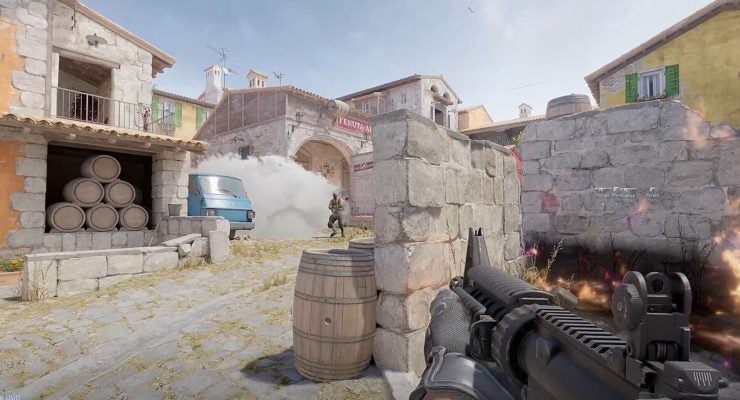Photo by Wikimedia Commons, CC by 2.0
For years, Counter-Strike Global Offensive – known as CS:GO – was the definitive first-person shooter in the world. There have been some hiccups since the game moved to its current generation, Counter-Strike 2, but it’s still the go-to competitive FPS for many gamers.
This guide will help you understand the fundamentals of CS2, including how to play and help getting started as a beginner.
What is CS2?
Counter-Strike 2 is, at its heart, a first person shooter game, or ‘FPS’. It puts two teams of five players against each other, with one team planting the bomb (Terrorists/T-Side), and the others aiming to either defuse it or stop it from being planted (Counter-Terrorists/CT-Side).
A normal CS2 match is 24 rounds long, with 12 rounds per half. The teams swap sides at halftime, and the first team to win 13 rounds takes the match.
If both teams are level at 12-12 after all 24 rounds, the game heads into overtime, which usually adds six more rounds, and the first team to win by two clear rounds gets the bragging rights.
CS2 also includes a few Hostage maps, like Office and Italy, where the gameplay and roles are a bit different.
The T-side must guard the hostages, while CTs work to rescue them and get them to safety. Office is available in competitive mode, whereas Italy is only playable in Casual.
You start the game with $800 and earn money by killing enemy players, planting/defusing the bomb, and winning the round. You then use this money to buy better weapons and equipment to win future rounds.
The game is free to play, though you cannot play ranked (Prime Status) until you either play your way to it or pay $14.99 to purchase access to it.
What are the Player Roles in CS2?
Players will tend to fit into a number of different roles as they play CS2 and improve.
Entry fragger – This is for players that are quick on the trigger, and are able to take the all-important one-v-one.
In-Game Leader – This is not the sort of role you’ll aim to go for first, however, if you know the maps you can be the play caller for your side.
Support – Playing alongside the entry fragger, support players will assist the entry player with flashes and smokes, as well as cleaning up if they die.
Lurk/Stealth – The lurker is your team’s flanking player. Look to sneak behind the enemy team or maybe solo plant the bomb at the opposite bomb site to your team.
AWPer/Sniper – One of the most important roles in CS2.
How to Play CS2
CS2 is a dynamic game when compared to other popular multiplayer games (See our LoL Beginner’s Guide here). With CS2, no one is assigned one of the above roles, it’s more that as a team you’ll naturally fall into them. Be that defending a certain site, or being your team’s AWPer.
The ultimate goal of the game is to get to 13 round victories, by winning rounds on either the Terrorist or Counter-Terrorist side. What side you start is random, though it will have an impact on if you’re in the early game advantage or not. Classically certain maps are more favoured to one side, so if you fall behind on one side, make sure not to lose your head.
To win, you’ll need to work as a team, manage your economy, and make individual decisions that see your team come out on top. Though, the first point, teamwork, is the most important if you want to move onto ranked CS2.
CS2 Weapons
Players get the chance to buy weapons at the beginning of each round. Your fund grows as you progress through the game, and any money left over carries forward. So, you need to plan how to use your budget to get the weapons that suit your strategy the most.
Ts and CTs each get their own set of weapons, with some gear locked to one side only. That said, everyone on the same team can buy from the same pool, provided you’ve got the money and have those weapons saved in your loadout.
How to Step Up your CS2 Game with Tips and Tricks
Once you’ve got a feel for CS2, it’s time to step up to the next level. Here are some useful tips and tricks as you move into ranked play:
Practice: If you want to get good at CS2, you’ll need to play it. Join gun-game servers to practice the full arsenal of weapons or join Deathmatch servers to get better at reaction fragging.
Aim training software: A simple search on Steam for Aim Training will yield countless results of games/software that are focused on improving your aim, and you won’t have to spend a penny.
Focus on the core weapons: AK-47 (T) and M4A4 (CT) are key weapons to learn and get used to as you start out. Focus on using these, then move on to the more advanced and specialist ones.
Check your bullets and don’t get killed reloading: One of the tips the game tells you early on is “it’s faster to swap to your pistol than it is to reload”. If you’re in a tight spot and low on ammo, remember that reloading makes a sound, and you might get pushed. You can also use this to your advantage by reloading and cancelling it to bait players to you.
Get good headphones and listen to sounds: Sound is a key mechanic in CS2, knowing how close players are to you and what gun people are using is key to your victory. Learn these sounds and use them to your advantage.
Communicate with your team: Talking to your team is a necessity. While you don’t need to be an in-game general, telling your team where enemy players are can save your team valuable seconds and might just be the difference between a round win or a loss.
Do not rush into ranked: CS2 is a tough nut to crack. Having been out for a long time, the game has a lot of highly skilled players. Take time to learn and get used to the game before getting your feet wet.
Start watching CS2 Esports and learn from the best: We’ll explain more below, however, CS2 has a wealth of professional talent that play on an almost daily basis. Either watch pro events or pro players on Twitch to help you improve.
What is CS2 Esports?
So you’ve learnt to play CS2 yourself, and you think you’ve got it mastered, now’s the time to look at the pro players.
So what is Counter-Strike 2 (CS2) Esports? In short, it’s one of the biggest and longest-running scenes in competitive gaming. With tournaments held worldwide, champions have come from South America, North America, Europe, and Asia alike. Europe has often dominated, but the rest of the world is always pushing to catch up.
CS2’s competitive scene is far less developer-led than most other esports. The competitive calendar is largely shaped by third-party organisers like ESL, BLAST, IEM, and DreamHack. In recent years, groups such as ESL and Flashpoint have even experimented with franchised leagues, like the ones we see in the American sports industry.
And that’s about all there is to know to get you started with CS2. Seek out groups, make friends, and watch YouTube videos/Twitch streams of professional players and you’ll be on the right track to improving.




